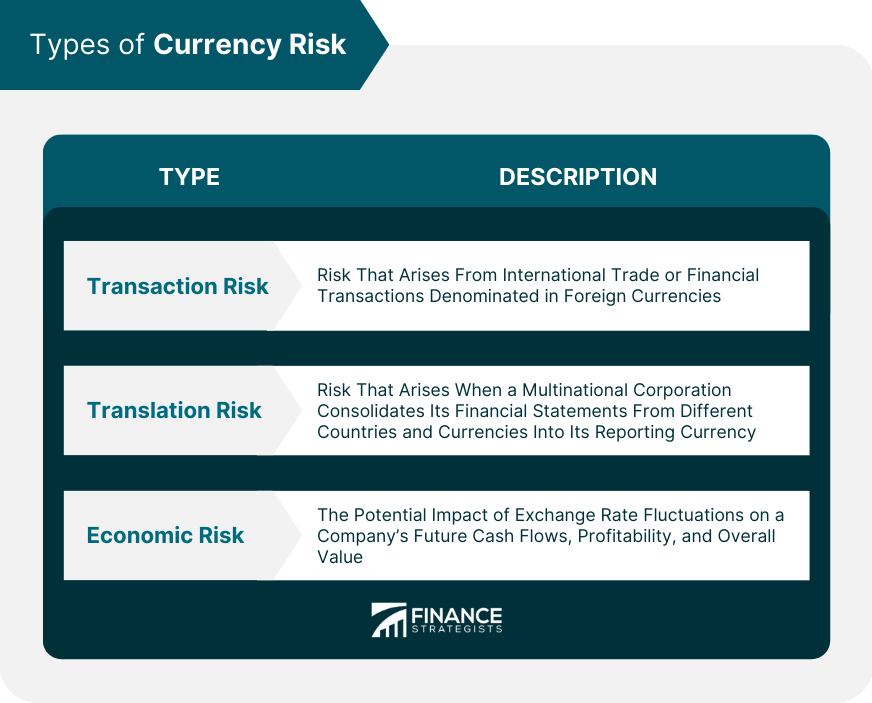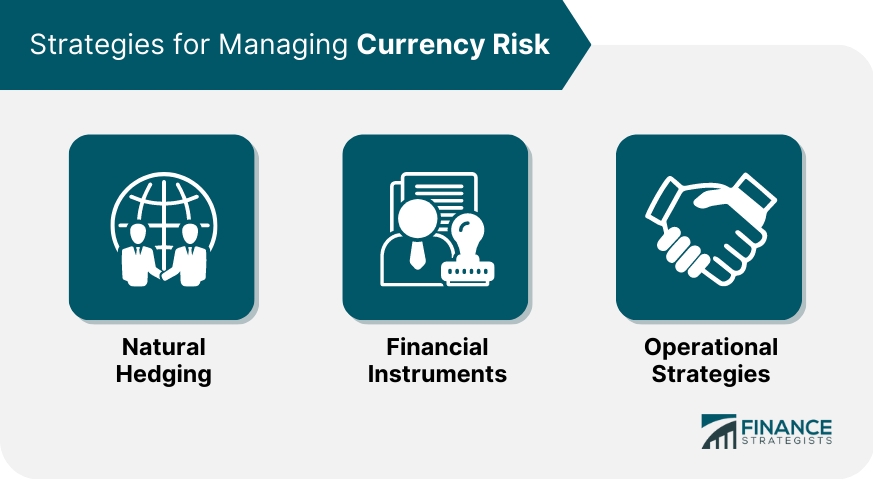Currency risk arises when the value of one currency changes in relation to another, affecting the value of transactions, investments, or assets denominated in foreign currencies. This risk can lead to significant financial losses for businesses and investors engaged in international trade or holding assets in foreign currencies. Proper currency risk management is essential to the success of businesses and investors operating in a global economy. By implementing effective strategies to manage currency risk, these entities can minimize potential losses, safeguard their financial position, and enhance overall performance. There are three main types of currency risk that businesses and investors should be aware of: transaction risk, translation risk, and economic risk. Understanding these different types of risk is essential for implementing effective currency risk management strategies. Transaction risk occurs when a company is involved in international trade or financial transactions denominated in foreign currencies. Changes in exchange rates between the time a transaction is agreed upon and the time it is settled can lead to fluctuations in the value of the transaction, potentially resulting in financial losses. Translation risk arises when a multinational corporation consolidates its financial statements from different countries and currencies into its reporting currency. Fluctuations in exchange rates can impact the value of assets, liabilities, and equity when they are translated, potentially affecting the company's financial position and performance. Economic risk, also known as operating risk, is the potential impact of exchange rate fluctuations on a company's future cash flows, profitability, and overall value. This type of risk is particularly relevant for companies with significant operations in foreign countries or those exposed to foreign markets. There are various strategies that businesses and investors can employ to manage currency risk effectively. These strategies can be broadly categorized into natural hedging, financial instruments, and operational strategies. Natural hedging involves managing currency risk through internal business operations, such as asset and liability management or currency diversification. By matching foreign currency assets and liabilities or diversifying currency exposure, businesses can reduce their overall currency risk. Financial instruments, such as forward contracts, futures contracts, options contracts, and currency swaps, can be used to hedge currency risk. These instruments allow businesses and investors to lock in exchange rates or obtain the right to exchange currencies at a predetermined rate, providing protection against adverse currency movements. Operational strategies involve managing currency risk through business practices, such as invoicing in the home currency or entering into risk-sharing agreements with counterparties. These strategies can help businesses minimize their exposure to currency risk and reduce the potential impact of exchange rate fluctuations on their financial position. In today's interconnected global economy, currency risk management is particularly important for multinational corporations and small and medium-sized enterprises (SMEs) engaged in international trade or investment. Multinational corporations often face significant currency risk due to their global operations and exposure to multiple currencies. Effective treasury management and a centralized or decentralized approach to risk management can help these corporations manage currency risk more effectively. SMEs often face unique challenges in managing currency risk, such as limited resources and access to financial instruments. Despite these challenges, there are solutions available for SMEs to effectively manage currency risk, such as working with financial service providers or implementing tailored risk management strategies. The digital age has brought about significant changes to the way businesses and investors manage currency risk. Technology and the rise of cryptocurrencies and blockchain have had a considerable impact on traditional currency risk management strategies. Advancements in technology have led to the development of risk management software, data analysis, and forecasting tools that help businesses and investors better understand and manage their currency risk. These tools enable more accurate assessments of risk exposure and facilitate the implementation of effective risk management strategies. The emergence of cryptocurrencies and blockchain technology has had a profound impact on currency risk management. While these digital assets introduce new types of risk, they also offer new strategies for managing currency risk, such as utilizing stablecoins pegged to traditional currencies or employing blockchain-based solutions for cross-border transactions. The regulatory environment plays a critical role in currency risk management. Monetary policy, central banks, and international financial regulations can all have a significant impact on exchange rates and the strategies businesses and investors use to manage currency risk. Monetary policy decisions by central banks, such as interest rate adjustments or quantitative easing measures, can influence exchange rates and, consequently, currency risk. Businesses and investors must stay informed about monetary policy developments to effectively manage their currency risk exposure. Central banks play a crucial role in managing currency risk by implementing monetary policy and intervening in foreign exchange markets when necessary. They also provide guidance and support to businesses and investors seeking to manage currency risk. International financial regulations, such as those established by the Basel Committee on Banking Supervision or the International Monetary Fund, can impact currency risk management by influencing exchange rates and the availability of financial instruments used to hedge currency risk. Compliance with these regulations is essential for businesses and investors operating in the global economy. Currency risk management is an essential aspect of doing business and investing in a global economy. By understanding the different types of currency risk and implementing effective strategies to manage them, businesses and investors can protect their financial position, minimize potential losses, and enhance overall performance. As technology and the global regulatory environment continue to evolve, staying informed about emerging trends and challenges in currency risk management will be increasingly important for success in the global marketplace.What Is Currency Risk Management?
Types of Currency Risk
Transaction Risk
Translation Risk
Economic Risk

Strategies for Managing Currency Risk
Natural Hedging
Financial Instruments
Operational Strategies

Currency Risk Management in a Global Economy
Multinational Corporations
Small and Medium-Sized Enterprises (SMEs)
Currency Risk Management in the Digital Age
Role of Technology
Cryptocurrencies and Blockchain
Regulatory Environment and Currency Risk Management
Impact of Monetary Policy
Role of Central Banks
International Financial Regulations
Conclusion
Currency Risk Management FAQs
Currency risk management is the process of identifying, measuring, and mitigating the risk of financial losses due to currency fluctuations.
Currency fluctuations can impact the profitability and cash flow of businesses, making it crucial to manage currency risk to minimize financial losses.
Currency risk management strategies include hedging, currency diversification, and invoice currency.
Tools such as forward contracts, options, and currency swaps are commonly used for currency risk management.
Small businesses can implement currency risk management by monitoring exchange rates, using forward contracts or options, and diversifying their currency holdings.
True Tamplin is a published author, public speaker, CEO of UpDigital, and founder of Finance Strategists.
True is a Certified Educator in Personal Finance (CEPF®), author of The Handy Financial Ratios Guide, a member of the Society for Advancing Business Editing and Writing, contributes to his financial education site, Finance Strategists, and has spoken to various financial communities such as the CFA Institute, as well as university students like his Alma mater, Biola University, where he received a bachelor of science in business and data analytics.
To learn more about True, visit his personal website or view his author profiles on Amazon, Nasdaq and Forbes.











